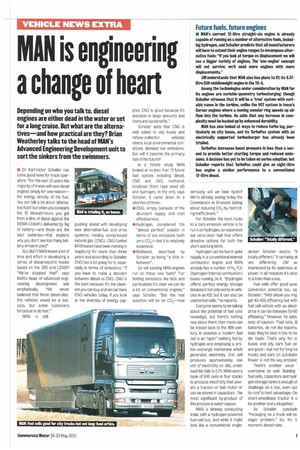Future fuels, future engines
Page 13

If you've noticed an error in this article please click here to report it so we can fix it.
• Midi's current 12-litre straight-six engine Is already capable of running on a number of alternative fuels, including hydrogen, and Schaller predicts that all manufacturers will have to extend their engine ranges to encompass alternative fuels: "If you look at torque vs displacement we will see a bigger variety of engines. The 'one-engine' concept will not survive; we'll need more engines with more displacements."
CM understands that MAN also has plans to fit its 6.87litre 008 middleweight engine in the TG-A.
Among the technologies under consideration by MAN for its engines are variable-geometry turbocharging: though Schaller stresses that it will be a 'true' system with variable vanes in the turbine, unlike the VGT system in Iveco's Cursor engines where a moving annular ring speeds up air flow into the turbine, He adds that any increase in complexity must be backed up by enhanced durability.
MAN has also looked at ways to reduce turbo lag, particularly on city buses, and its TurboPac system with an electrically supported turbocharger has already been triailed.
TurboPac increases boost pressure in less than a second to provide better starting torque and reduced emissions. A decision has yet to be taken on series adoption. but Schaller reports that TurboPac could give an eight-litre bus engine a similar performance to a conventional 12-litre diesel.




























































































































